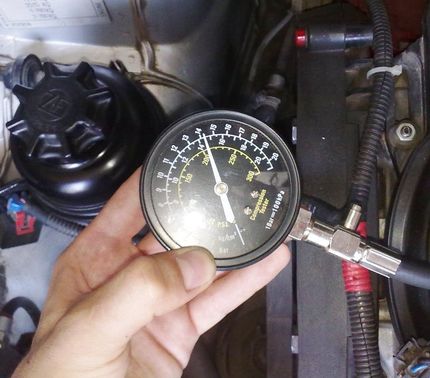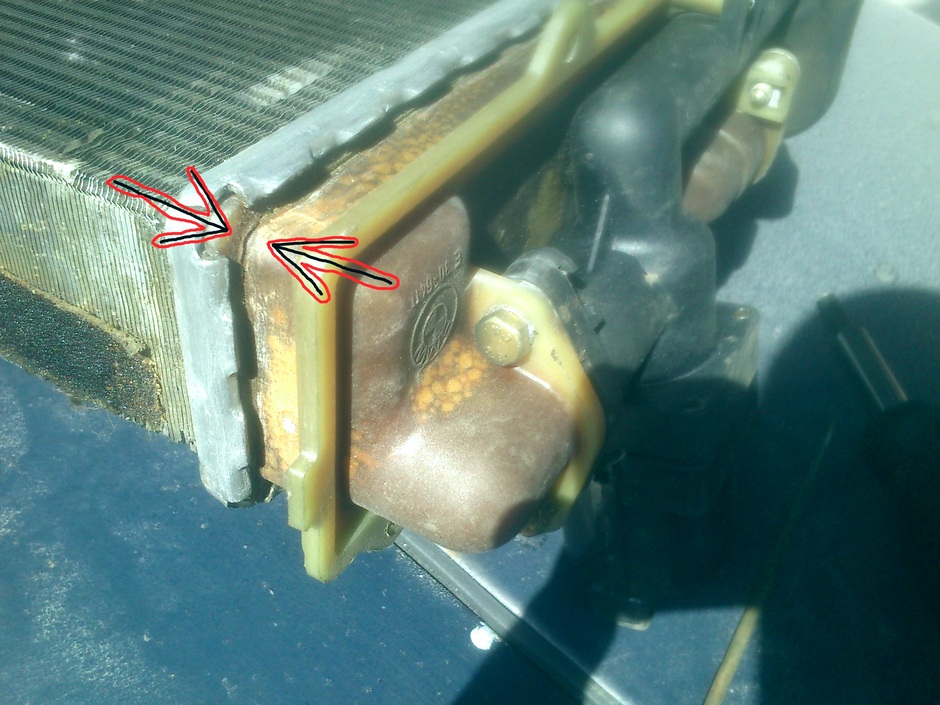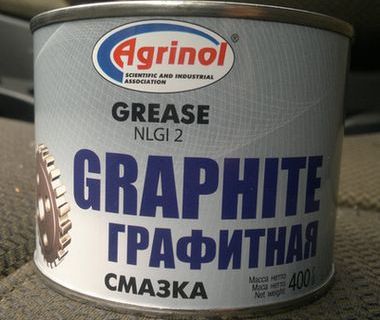
Graphite grease and its use in cars
Content
Graphite grease - inorganic lubricant as well, black or dark brown in color, with a dense and highly viscous consistency. Outwardly, it resembles the well-known grease. The lubricant is made on the basis of vegetable fats using petroleum cylinder oil fluids and lithium or calcium soaps, as well as graphite. Graphite powder is used as the latter. In accordance with GOST 3333-80, according to which it is manufactured, the optimal use temperature is from -20°C to +60°C, however, in reality, it can withstand even more critical temperatures. Graphite grease is widely used in industry, as well as in machine transport. namely, it is smeared with springs, suspension elements, heavily loaded bearings, open gears, and so on.
Composition of graphite lubricant
First of all, you need to know that in the technical literature, the term "graphite lubricant" can mean various compositions. The fact is that initially this definition refers to an inorganic lubricant, for which graphite is used as a thickener, but in a broad sense, lubricants are also called so, where graphite is used as an additive. So, the term "graphite lubricant" can mean:
crushed graphite
- ordinary graphite powder, which can be used as a solid lubricant;
- soap-based lubricant containing graphite;
- graphite suspension in oil solution (inorganic type lubricant).
It is the latter composition that is most often called graphite grease, and it will be discussed further. Its manufacturing technology involves thickening a viscous organic or synthetic oil, which is obtained from petroleum products, with calcium soap and graphite powder. In other words, we can say that graphite powder is added to the classic grease, which gives the lubricant its properties.
Currently, copper-graphite grease can also be found on sale. Copper powder is added to its composition. It is able to withstand high temperatures. Usually copper-graphite grease is available in the form of aerosols. Looking ahead, let's say that often this composition is applied to the caliper guides. This way you can avoid sticking discs and / or brake drums to the hub flanges.
Properties of graphite grease
By itself, graphite conducts heat and electricity well, does not collapse under the influence of moisture, is not affected by static electricity, and is also thermally stable (it can withstand high temperatures). All these properties, although to a lesser extent, have the corresponding lubricant.
What is good graphite lubricant? Its advantages include:
- chemical resistance (when applying lubricant to working surfaces, its elements do not enter into a chemical reaction with it);
- thermal resistance (does not evaporate up to a temperature of +150°C, since the concentration of volatile substances in its composition is minimal, does not lose its performance characteristics at high temperatures);
- protects work surfaces from moisture;
- has increased colloidal stability;
- explosion-proof;
- has excellent lubricating properties;
- increases wear resistance, mechanical performance and service life of the mechanism where it is used;
- minimizes the number of seizures;
- not affected by oil, that is, remains on the surface even if it is present;
- graphite grease adheres well to any surface;
- resistant to static electricity;
- has high adhesive and antifriction properties.
also one important advantage of graphite grease is its low price with satisfactory performance. Although, in fairness, it should be noted that at present there are many other, more advanced lubricants, which, although they are more expensive, have better performance.
However, graphite grease also has disadvantages. namely, it cannot be used in mechanisms with high precision, since solid impurities present in graphite will contribute to increased wear of parts;
Features
The current GOST 3333-80, as well as the relevant technical conditions, indicate the technical and operational characteristics of graphite grease.
| Characterization | Value |
|---|---|
| Temperature range of application | from -20°C to +60°C (however, it is allowed to use grease at temperatures below -20°C in springs and similar devices) |
| Density, g/cm³ | 1,4 ... 1,73 |
| Drop point | not lower than +77°C |
| Penetration at +25°C with agitation (60 double cycles) | not less than 250 mm/10 |
| Colloidal stability, % of released oil | no more 5 |
| Mass fraction of water | no more 3% |
| Shear strength at +50°С | not less than 100 Pa (1,0 gf/cm²) |
| Viscosity at 0°С in the average strain rate gradient 10 1/s | no more than 100 Pa•s |
| Tensile strength at +20°С, kg/cm² | |
| tensile | 120 |
| for compression | 270 ... 600 |
| Electrical resistance | 5030 om•sm |
| Temperature, ° C | |
| decomposition | 3290 |
| maximum allowable operating | 540 |
| average allowable operating | 425 |
| Grease oxidation products | CO, CO2 |
| NLGI class | 2 |
| Designation according to GOST 23258 | SKa 2/7-g2 |
When working with grease, you must remember and follow the rules below for the safe operation of graphite grease.
Observe the following safety and fire precautions when handling grease:
- Graphite grease is explosion-proof, its flash point is +210°С.
- When spilled on the surface, the lubricant should be collected in a container, the spill area should be wiped dry with a rag, which should then be placed in a separate, preferably metal, box.
- In the event of a fire, the main fire extinguishing agents are used: water mist, chemical, air-chemical foam, high-expansion foam and appropriate powder compositions.
Application area
The scope of graphite grease is very wide. In production, it is lubricated with:
- special equipment springs;
- slow-moving bearings;
- open and closed shafts;
- various gears;
- stop valves;
- suspensions in large-sized mechanisms, special equipment;
- drilling rig supports.
Now we briefly list the components and mechanisms of the car that can be lubricated with this composition (taking into account some features):
- steering joints;
- steering rack (namely, the rack housing is disassembled and the working gear is lubricated);
- elements of the steering mechanism (with the exception of those where gear oils are used as lubricants);
- ball bearings;
- anti-creak washers in the springs;
- anthers of steering tips and rods;
- thrust bearings;
- steering knuckle bearings (for prevention, grease is also stuffed into a protective cap);
- cable drive parking brake;
- machine springs;
- on rear-wheel drive vehicles, it can be used for propeller shaft crosspieces.
graphite grease can also be used as a prophylactic. namely, it can be used to lubricate threaded connections, ordinary and machine locks in summer and especially in winter.
Many motorists are also interested in the question of whether it is possible to lubricate CV joints (constant velocity joints) with graphite. There is no single answer in this case. If we are talking about cheap domestic lubricant, then you should not take risks, it can ruin the internal mechanism of the hinge. If you use imported expensive lubricants (for example, Molykote BR2 plus, Molykote Longterm 2 plus, Castrol LMX and other materials containing graphite), then you can try. However, remember that there are special lubricants for CV joints.
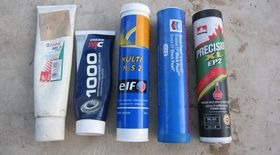
CV joint grease
Timely lubrication of the CV joint reduces its wear and extends its service life. Each type of hinge requires its own type of lubricant. Find out which one needs to be smeared and which is better from reviews and a review of characteristics. More details
It is worth dwelling separately on the question of whether it is possible to lubricate the battery terminals with graphite grease. Yes, its composition conducts electricity, but there is a risk of overheating due to the fact that it has a high resistivity. Therefore, "graphite" can be used to lubricate the terminals, but it is undesirable. Lubrication will prevent the surface from corrosion. Therefore, it is better to use other means to lubricate the battery terminals.
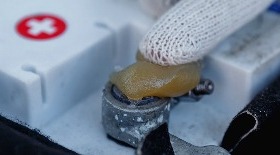
How to lubricate battery terminals
Lubricants for battery terminals can range from traditional “old-fashioned” ways to protect battery terminals from oxidation, to modern ones, with impurities that improve electrical conductivity. More details
How to remove graphite grease
Using lubricant without care can easily stain your clothes. And it will no longer be easy to remove it, because it is not only fat, but also graphite, which is difficult to wipe off. Therefore, a very interesting question arises: how can you wipe off or wipe off graphite grease. On the Internet there are many different disputes and opinions on this matter. We offer your opinion several remedies that should help in this (the fact is that in each individual case different remedies can help, it all depends on the degree of contamination, type of fabric, duration of contamination, additional impurities, and so on). So, they will help you:
Antipyatin
- gasoline (preferably 98th, or pure aviation kerosene);
- grease cleaner (for example, "Antipyatin");
- "Sarma gel" for dishes;
- non-contact car wash shampoo (spray the aerosol on dirt, then try to gently wipe it off);
- hot soapy solution (if the pollution is not strong, then you can soak the clothes for a while in a solution of laundry soap, and then wipe it off by hand);
- "Vanish" (similarly, you need to pre-soak the clothes and let them stand for several hours, you can wash them by hand or in a washing machine).
Some car owners recommend washing clothes in a washing car at the highest temperature. Remember that for some types of fabrics this is unacceptable! They may lose structure and the clothing cannot be restored. Therefore, read what is indicated on the appropriate label on the clothes, namely, at what temperature the product can be washed.
How to make graphite grease with your own hands

Do-it-yourself graphite grease
Due to the popularity of graphite grease among automakers, as well as the simplicity of its composition, there are several folk methods with which you can make this lubricant at home.
you need to take graphite powder, grease and machine oil. Their ratio may be different. The basis is liquid oil, to which grease is added, and then graphite (you can use a frayed pencil lead or worn brushes of an electric motor or current collector as it). then this mass must be stirred until a consistency similar to sour cream is obtained. Gear oil can be used instead of machine oil.
However, you need to understand that home-made mixtures will not meet the stated GOST, so such lubricants will not meet its standards. In addition, the shelf life of home-made graphite lubricants will be significantly lower than the factory one.
Copper-graphite grease
As mentioned above, an improved version of the classic graphite grease is copper-graphite grease. From the name it is clear that copper powder is added to its composition, which significantly improves the performance properties. The features of the composition of copper-graphite grease include:
Copper-graphite grease
- the ability to work at high temperatures (in this case, it is impossible to indicate a clear range, since different compositions with different properties are on the market, some of them are able to work at temperatures of about + 1000 ° C and above, read the details in the product description);
- the ability to withstand high mechanical loads (similar to the previous paragraph);
- increased level of adhesion and stickiness;
- complete exclusion of corrosion formations on the protected surfaces;
- resistance to oil and moisture;
- The composition of the lubricant does not include lead, nickel and sulfur.
for example, copper-graphite grease perfectly protects work surfaces even under extreme operating conditions. Often threaded connections are treated with this tool before connecting them. This makes it possible to unscrew the connection in the future without problems.
Popular manufacturers
Finally, let's briefly dwell on some domestic manufacturers producing graphite grease. It’s worth saying right away that their products are in many ways similar to each other, so it doesn’t really matter which brand of lubricant you buy. Domestic graphite grease meets GOST 3333-80, so all products will be approximately the same.
So, in the post-Soviet space, graphite lubricants are manufactured by:
- LLC "Colloid-graphite preparations" This enterprise produces graphite lubricants for industries. Performs wholesale deliveries.
- Oil Right. As of the end of 2021, a tube weighing 100 grams costs 40 rubles. The catalog number of the product is 6047.
- TPK "RadioTechPayka". A jar of 25 grams costs 30 rubles, a tube of 100 grams costs 70 rubles, and a jar of 800 grams costs 280 rubles.
As for foreign manufacturers, their products have a more perfect composition. usually, in addition to graphite, the composition of the funds includes modern additives and elements that increase their operational means. In this case, their description is not worth it, firstly, because the choice must be made on the basis of the goal facing the consumer, and secondly, the number of lubricants and manufacturers is simply huge!
Instead of a conclusion
Graphite grease is a cheap and effective tool for protecting working surfaces from corrosion, increasing the performance of working pairs, as well as increasing their working life. However, when using it, remember that the lubricant cannot be used in high-speed mechanisms and where high precision is required from working surfaces. Therefore, use it in the nodes mentioned above, and given its low price, it will serve you well in protecting the parts of your car.
